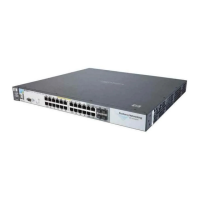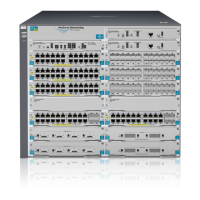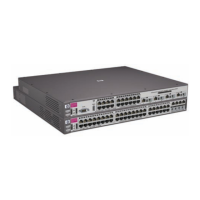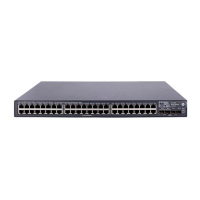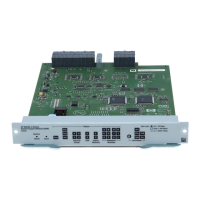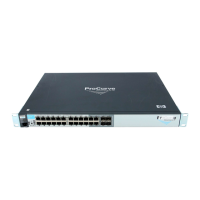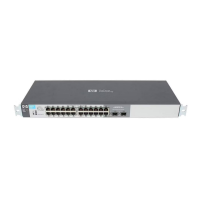Do you have a question about the HP ProCurve 3500yl Series and is the answer not in the manual?
| Model | HP ProCurve 3500yl Series |
|---|---|
| Switching Capacity | 176 Gbps |
| Layer | Layer 3 |
| Input Voltage | 100-240 VAC |
| PoE | Available on some models |
| Management | Web, CLI, SNMP |
| Routing Protocol | RIP, OSPF, BGP |
| Remote Management Protocol | Telnet |
| Features | VLAN |
| Power Consumption Operational | Varies by model |
| Memory | 256 MB |
| Power Supply | Internal |
| Security Features | 802.1X, RADIUS, TACACS+ |
| Ports | 24 or 48 x 10/100/1000Base-T ports |
Explains the OSI model precedence for implementing security features on traffic.
Details how to configure local password security via menu, CLI, and web interfaces.
Covers features related to the switch's front-panel buttons for security management.
Details the procedure to disable the password-clearing function of the Clear button.
Describes the password recovery feature and its requirements.
Describes how connection-rate filtering works to detect and respond to malicious traffic.
Covers enabling connection-rate filtering and applying policies on a per-port basis.
Details commands to enable connection-rate filtering globally and per-port.
Explains the syntax and options for enabling filtering and setting global sensitivity levels.
Describes how to set per-port policies like notify-only, throttle, and block.
Shows how to view current configuration, status, and blocked hosts.
Explains how to list and unblock hosts affected by connection-rate filtering.
Details how to configure and apply Access Control Lists for connection-rate filtering exceptions.
Covers configuring ACLs based on source IP address criteria.
Details configuring ACLs using UDP/TCP criteria.
Explains the operational flow of authenticator operation, Web-based, and MAC-based authentication.
Details the process of authenticating users via a web page login.
Explains how devices are authenticated using their MAC addresses via a RADIUS server.
Outlines the steps required before configuring Web/MAC authentication.
Details the commands and procedures to configure the switch to access a RADIUS server.
Covers the steps and considerations for setting up Web authentication on switch ports.
Lists the commands and parameters for configuring Web-based authentication.
Details the steps for configuring MAC authentication on switch ports.
Lists the commands and parameters for configuring MAC-based authentication.
Covers the steps and commands for configuring TACACS+ authentication on the switch.
Describes how to configure access control for console and Telnet using AAA authentication.
Covers the configuration parameters for the switch to access TACACS+ servers.
Provides a general procedure for preparing and configuring RADIUS on the switch.
Details the steps for configuring RADIUS authentication for various access methods.
Guides on configuring RADIUS for serial port, Telnet, SSH, and web access.
Covers configuring the switch to interact with RADIUS servers for authentication and accounting.
Details the configuration of global RADIUS parameters like timeout and retransmit attempts.
Outlines the steps to configure RADIUS accounting on the switch.
Provides a step-by-step guide for configuring RADIUS accounting.
Explains how to configure accounting types (exec, network, system) and report triggers.
Outlines the steps for configuring SSH for two-way authentication.
Details the process of configuring the switch for SSH operation.
Explains how to generate the necessary RSA host key pair for SSH on the switch.
Details methods for copying the switch’s public key to client "known hosts" files for secure access.
Covers enabling SSH and understanding client connection behavior, including security prompts.
Explains how to configure SSH authentication methods for login and enable access levels.
Outlines the general steps for SSL configuration and client authentication.
Details the process of configuring the switch for SSL operation.
Explains how to generate a server host certificate for SSL.
Guides on generating a self-signed host certificate using the web browser interface.
Details the process of generating a CA-signed server host certificate via the web interface.
Covers enabling SSL and understanding browser interaction after configuration.
Explains how source-port filters enable forwarding or dropping traffic based on source port.
Describes how to specify named source-port filters for use on multiple ports and trunks.
Details the CLI commands for defining and configuring named source-port filters.
Details the procedure for specifying filter types and actions on the switch.
Guides on configuring source-port traffic filters using the `filter` command.
Explains client-level security allowing LAN access via valid user credentials.
Describes port-level security recommended for applications with single client per port access.
Outlines the steps required before configuring 802.1X operation.
Outlines the steps for configuring 802.1X authentication on the switch.
Details how to configure switch ports to operate as 802.1X authenticators.
Covers enabling 802.1X authentication on specific ports for authenticator operation.
Covers the core functionality of port security for authorizing devices and detecting violations.
Details CLI commands for configuring port security and acquiring authorized addresses.
Covers configuring port security, editing settings, and clearing intrusion flags.
Covers MAC Lockdown (static addressing) for preventing MAC address hijacking and controlling address learning.
Explains MAC Lockout as a simple blacklist to drop traffic to/from specified MAC addresses.
Covers how the switch handles and notifies about security violations and intrusion alerts.
Explains the importance of resetting alert flags to manage intrusion log entries.
Details how to authorize single stations or groups of stations via IP addresses and masks.
Covers the syntax and parameters for configuring IP authorized managers.
Explains how IP mask parameters control the use of Authorized Manager IP values.
Details the steps for configuring key chains within the KMS.

